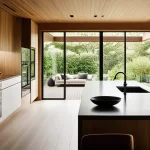Essential strategies to boost natural light in UK homes
Maximizing natural light in UK homes significantly enhances well-being and comfort by creating brighter, more inviting spaces. However, the typical UK housing design often presents challenges such as smaller window areas and orientation issues that limit daylight indoors. To effectively improve daylight indoors, it is crucial to blend quick-win solutions with long-term natural lighting solutions.
Start by focusing on window placement enhancements, which includes enlarging or reorienting windows where possible to capture more sunlight. Next, select proper glazing materials like double glazing or light-enhancing glass that allow maximum light transmission while maintaining insulation. Interior finishes also play a vital role; using light wall colors or reflective paint can amplify brightness, while strategic use of mirrors aids in redirecting sunlight deeper into rooms.
Also read : How Can Sustainable Design Transform Your Home Living Experience?
In addition, keeping windows clean and free of obstructions ensures that natural light isn’t unnecessarily blocked. Decluttering and adopting open-plan layouts further facilitate the smooth flow of daylight indoors. Combining these strategies helps UK homeowners optimize natural light effectively, creating healthier and more comfortable living environments without drastic structural changes.
Essential strategies to boost natural light in UK homes
Maximizing natural light in UK homes is vital for enhancing well-being and creating comfortable living spaces. Natural lighting solutions directly influence mood, productivity, and even energy savings. However, achieving abundant daylight indoors can be challenging due to the typical UK housing design—often characterized by smaller windows and tightly packed properties limiting sunlight access.
Also read : How Can You Transform Your Home into a Cozy British Haven?
To improve daylight indoors effectively, homeowners should focus on a mix of quick-win strategies and long-term improvements. Simple actions like decluttering and adopting minimalistic décor can immediately enhance light flow, while structural upgrades, such as installing skylights, provide sustained benefits. Prioritizing the placement and size of windows is another key approach because well-positioned windows maximize the amount of daylight entering rooms.
Additionally, choosing the right glazing, such as double glazing with light-enhancing glass, helps increase light transmission while maintaining insulation. Keeping windows clean and unobstructed further ensures the fullest daylight benefit. Combining these natural lighting solutions tailored to the unique constraints of UK homes enables a balanced, bright, and inviting indoor environment year-round.
Window placement and glazing techniques
Optimizing window placement is a pivotal step to maximize natural light in UK homes. Positioning new windows on south-facing walls captures the most sunlight throughout the day, while enlarging existing windows can notably improve daylight indoors. When structural changes aren’t feasible, even modest increases in window size or installing additional side windows help brighten interiors.
Selecting the right glazing is equally crucial. Double glazing offers excellent insulation while ensuring ample light transmission. For enhanced efficiency, low-emissivity (low-E) glass reduces heat loss yet allows light to penetrate. Light-enhancing glass types with higher visible light transmittance amplify indoor brightness without compromising thermal performance. This balance is vital given UK climate considerations.
Maintaining clean, unobstructed windows is a simple but often overlooked natural lighting solution. Dirt, condensation, and cluttered window sills can reduce light penetration by 15-20%, diminishing the benefits of even well-placed windows. Regular cleaning coupled with minimal external obstructions like overgrown shrubs or heavy curtains enables maximum daylight flow.
Collectively, these glazing and window placement strategies form foundational methods to improve daylight indoors, tailored to the unique challenges of UK housing design.
Window placement and glazing techniques
Optimizing window placement in UK homes is a pivotal natural lighting solution. Positioning windows to face the sun’s path maximizes natural light indoors. Enlarging existing windows or adding new ones in sun-exposed walls significantly boosts daylight penetration. For instance, south-facing windows capture more light throughout the day, while east-facing ones bring in morning brightness.
Choosing the right glazing further enhances daylight without sacrificing energy efficiency. Double glazing is standard for insulation but selecting variants with light-enhancing glass or low-emissivity (low-E) coatings allows higher light transmission and reduces heat loss. These technologies ensure homes remain bright and warm, addressing UK homes’ unique weather challenges.
Maintaining clean, unobstructed windows is essential. Dirt, grime, or external obstacles like overgrown bushes reduce incoming light. Regular cleaning combined with thoughtful landscaping ensures optimal daylight access. In summary, integrating smart window placement with advanced glazing materials, while keeping windows clear, offers a practical, effective approach to improve daylight indoors in UK homes.
Interior finishes to reflect and spread daylight
Choosing the right light wall colors is fundamental when aiming to boost natural light in UK homes. Lighter shades, such as whites, creams, and pastels, have high reflectance and maximize reflection of daylight, making interiors feel brighter and more spacious. Semi-gloss or satin finishes, compared to matte paints, add subtle shine to surfaces, further enhancing light diffusion.
Incorporating reflective paint in key areas like ceilings or accent walls can amplify brightness without major renovation. Beyond walls, selecting furniture and décor with glossy or reflective surfaces also aids in spreading daylight throughout rooms, reducing shadows and dark corners.
Using mirrors strategically is another effective natural lighting solution to improve daylight indoors. Placing mirrors opposite windows or in darker parts of a room redirects sunlight deeper inside, effectively multiplying available light. This approach benefits rooms with limited or poorly oriented windows, common in many UK homes.
Together, these interior finishes work harmoniously with window placement and glazing techniques to create consistently bright and welcoming spaces, achieving well-lit, comfortable environments that feel naturally illuminated all day.
Interior finishes to reflect and spread daylight
Choosing the right light wall colors is a fundamental natural lighting solution to brighten UK homes. Lighter shades like soft whites, creams, and pastels reflect more sunlight, helping to maximize natural light indoors. Reflective paint finishes with a slight sheen can further enhance this effect by scattering incoming daylight across room surfaces, contributing to a brighter ambiance.
Incorporating glossy or semi-gloss surfaces in furniture and décor also adds to the reflectivity. For example, polished wooden floors or glass-topped tables bounce light deeper into the room, improving overall illumination. This approach complements window placement and glazing efforts by effectively redistributing natural light already entering a space.
Using mirrors strategically is another proven way to improve daylight indoors. Placing mirrors opposite or adjacent to windows amplifies sunlight by reflecting it into darker corners or hallways that otherwise remain shaded. This method is especially useful in smaller UK homes where the footprint limits direct light penetration.
By combining reflective paint, bright interiors, and thoughtfully placed mirrors, homeowners can significantly enhance the flow and spread of daylight. These practical natural lighting solutions work well without the need for structural changes, making them suitable for both renters and owners aiming to brighten their UK homes.
Layout adjustments and minimalistic décor
Embracing open-plan layouts is a practical natural lighting solution to improve daylight indoors in UK homes. By removing walls or partitions where possible, light flows more freely through connected spaces, reducing dark corners and creating a more spacious feeling. Even partial openings in walls allow sunlight to permeate deeper into the home, maximizing natural light benefits.
Decluttering is another quick-win approach. Excess furniture or bulky items near windows block incoming light, diminishing brightness. Removing unnecessary pieces or choosing streamlined furniture enhances natural light penetration and contributes to a cleaner, airier atmosphere.
Selecting lightweight window treatments such as sheer curtains or blinds instead of heavy drapes ensures windows remain unobstructed during the day. This allows maximum daylight to enter while still providing privacy. Additionally, thoughtful space planning for light—placing frequently used seating or work areas near windows—leverages natural light for comfort and energy savings.
Together, these layout and décor strategies complement glazing and interior finishes, offering affordable ways UK homeowners can boost natural light without major structural changes. Prioritizing open, clutter-free spaces effectively transforms darker homes into bright, welcoming environments year-round.
Layout adjustments and minimalistic décor
Adopting open-plan layouts is a highly effective natural lighting solution to improve daylight indoors. By reducing interior walls or using partial partitions, open spaces allow light to travel freely, brightening multiple areas simultaneously. This approach is particularly valuable in typical UK homes, where smaller rooms and tight plans often restrict light flow.
Minimizing bulky furniture and clutter is key to maximizing natural light. Large furnishings and excess items block sunlight paths, creating unwanted shadows. Decluttering opens sightlines, allowing daylight to reach further into rooms. Choosing minimalistic décor with clean lines and fewer obstructions significantly enhances the light environment.
Window treatments also influence light penetration. Heavy curtains or dark blinds can severely limit incoming daylight. Selecting lightweight, sheer materials lets light filter while maintaining privacy. This subtle adjustment integrates well with minimalistic décor and improves overall brightness.
Together, thoughtful space planning, decluttering, and using light fabrics establish a harmonious balance that supports natural lighting solutions in UK homes. These changes require little investment yet provide noticeable improvements, making them ideal for quick-win strategies to brighten interiors effectively.
Enhancing natural light through structural upgrades
Installing skylights and roof windows is a highly effective natural lighting solution for UK homes, especially where vertical window expansion is restricted. These upgrades introduce top-down illumination, significantly increasing the amount of daylight indoors by capturing direct sunlight from above. Unlike traditional windows, skylights bring light deeper into the home’s core, enhancing natural brightness throughout the day.
Adding internal glazing, such as glass partitions or doors, further optimizes daylight distribution by connecting naturally lit spaces to adjacent rooms that might otherwise remain dim. This method maintains an open feeling while improving light flow without major alterations to the layout.
Cost-effective upgrades like these balance enhanced natural light with energy efficiency. Modern skylights often feature advanced double glazing and low-emissivity coatings that minimize heat loss and reduce solar gain, vital for UK’s variable climate. Choosing products with high thermal performance ensures improvements do not compromise insulation, contributing to sustainable living.
By adopting structural upgrades thoughtfully, UK homeowners can achieve significant improvements in natural light. These solutions blend well with prior strategies such as window placement and interior finishes to create brighter, healthier, and more inviting homes year-round.



